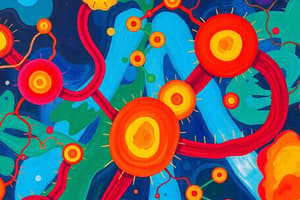Podcast
Questions and Answers
What is the main function of ATP in cells?
What is the main function of ATP in cells?
- To act as a carrier for electrons
- To store genetic information
- To serve as the source of usable energy (correct)
- To facilitate the breakdown of proteins
Which statement about glycolysis is true?
Which statement about glycolysis is true?
- It transforms glucose into pyruvic acid (correct)
- It occurs only in eukaryotic cells
- It requires oxygen to proceed
- It yields carbon dioxide as a byproduct
What role do redox reactions play in ATP synthesis?
What role do redox reactions play in ATP synthesis?
- They generate electron donors and acceptors (correct)
- They directly produce ATP without intermediates
- They absorb energy to create ATP
- They store energy in high energy phosphate bonds
Which of the following accurately describes the phosphorylation of ADP?
Which of the following accurately describes the phosphorylation of ADP?
In the context of catabolic pathways, what is the main goal?
In the context of catabolic pathways, what is the main goal?
What distinguishes oxidative phosphorylation from substrate level phosphorylation?
What distinguishes oxidative phosphorylation from substrate level phosphorylation?
What happens when an enzyme is denatured?
What happens when an enzyme is denatured?
Which electron carriers are primarily involved in shuttling energy in respiratory pathways?
Which electron carriers are primarily involved in shuttling energy in respiratory pathways?
What is the primary function of catabolism in cellular metabolism?
What is the primary function of catabolism in cellular metabolism?
How do enzymes increase the rate of metabolic reactions?
How do enzymes increase the rate of metabolic reactions?
Which statement accurately describes the active site of an enzyme?
Which statement accurately describes the active site of an enzyme?
What distinguishes exoenzymes from endoenzymes?
What distinguishes exoenzymes from endoenzymes?
Which type of cofactor is considered organic and can be a vitamin?
Which type of cofactor is considered organic and can be a vitamin?
What characterizes constitutive enzymes?
What characterizes constitutive enzymes?
What impact do cold temperatures have on enzymatic activity?
What impact do cold temperatures have on enzymatic activity?
Which of the following enzymes is produced by Streptococcus pyogenes?
Which of the following enzymes is produced by Streptococcus pyogenes?
Flashcards are hidden until you start studying
Study Notes
Metabolism of Microbes
- Metabolism encompasses all chemical reactions in a cell, divided into anabolism and catabolism.
- Anabolism assembles smaller molecules into larger macromolecules, while catabolism breaks down macromolecules and releases energy as ATP or heat.
Enzymes
- Enzymes are proteins that catalyze metabolic reactions, aiding in life’s chemical processes.
- Catalysts participate in reactions without being consumed or transforming into products.
- Enzymes lower the energy of activation, the energy required for reactions to occur.
- Substrates are the specific substances that enzymes act upon, and enzyme names typically end in -ase.
- Enzymes can be simple (consisting of just proteins) or conjugated (containing non-protein cofactors).
Cofactors
- Cofactors are essential for enzyme function and include two types: coenzymes (organic) and inorganic metal ions.
- Metallic cofactors (like iron or copper) participate directly in reactions.
- Coenzymes and vitamins act in transferring functional groups in metabolic processes.
Enzyme Specificity
- The active site of an enzyme is where the substrate binds, enabling a temporary union via weak, reversible bonds.
- Enzymes are specific, meaning one enzyme typically binds to one substrate.
- Upon reaction, products are formed and released from the enzyme.
Classification of Enzymes
- Exoenzymes are secreted outside the cell, while endoenzymes remain intracellular.
- Constitutive enzymes are always produced, whereas regulated enzymes are synthesized in response to substrate concentration.
- Reactions can be dehydration (releasing water and utilizing energy) or hydrolysis (requiring water).
Role of Microbial Enzymes in Disease
- Some microbes produce exoenzymes that function as virulence factors or toxins.
- Examples include streptokinase from Streptococcus pyogenes and elastase from Pseudomonas aeruginosa.
Environmental Sensitivity of Enzymes
- Cold temperatures slow catalysis due to reduced molecular motion.
- High temperatures can cause denaturation, resulting in loss of enzyme function.
Energy Utilization in Cells
- Cells extract energy from molecules and convert it into ATP, a storable form of energy.
- Redox reactions are vital, involving the transfer of electrons between donors (oxidized) and acceptors (reduced) to generate ATP.
Adenosine Triphosphate (ATP)
- ATP consists of ribose sugar, adenine, and three phosphate groups; energy is stored in high-energy bonds between phosphates.
- Energy is released when the bond between the last two phosphates is broken, forming ADP and inorganic phosphate.
- ATP synthesis occurs through substrate-level phosphorylation or oxidative phosphorylation.
Catabolic Pathways
- The goal of catabolic pathways is to release energy from glucose and convert it to ATP.
- Pathways begin with glycolysis, which generates pyruvic acid and some ATP and NADH.
- Aerobic respiration includes glycolysis followed by the Krebs cycle, producing carbon dioxide, additional ATP, and electron carriers.
Studying That Suits You
Use AI to generate personalized quizzes and flashcards to suit your learning preferences.




